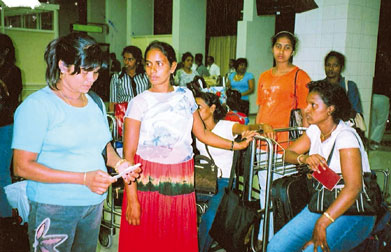The impact of remittances on financial development
Maria Soledad Martinez Peria
Remittances, funds received from migrants working abroad, to
developing countries have grown dramatically in recent years from U.S.
$3.3 billion in 1975 to close to U.S. $338 billion in 2008.
 |
|
Remittances, funds received from
migrants working abroad, to developing countries have grown
dramatically |
They have become the second largest source of external finance for
developing countries after foreign direct investment (FDI) and represent
about twice the amount of official aid received.
Relative to private capital flows, remittances tend to be stable and
increase during periods of economic downturns and natural disasters.
Furthermore, while a surge in inflows, including aid flows, can erode
a country's competitiveness, remittances do not seem to have this
adverse effect.
As researchers and policymakers have come to notice the increasing
volume and stable nature of remittances to developing countries, a
growing number of studies have analyzed their development impact along
various dimensions, including: poverty, inequality, growth, education,
infant mortality, and entrepreneurship.
However, surprisingly little attention has been paid to the question
of whether remittances promote financial development across
remittance-recipient countries.
Yet, this issue is important because financial systems perform a
number of key economic functions and their development has been shown to
foster growth and reduce poverty.
Furthermore, this question is relevant since some argue that banking
remittance recipients will help multiply the development impact of
remittance flows.
Whether and how remittances might affect financial
development-banking in particular-is a priori unclear.
On the one hand, money transferred through financial institutions
might pave the way for recipients to demand and gain access to other
financial products and services that they might not have otherwise.
As an added benefit, providing remittance transfer services allows
banks to "get to know" and reach out to unbanked recipients or
recipients with limited financial intermediation.
For example, remittances might have a positive impact on credit
market development if banks become more willing to extend credit to
remittance recipients because the transfers they receive from abroad are
perceived to be significant and stable (i.e., serve as collateral, at
least informally). However, even if bank lending to remittance
recipients does not materialize, overall credit in the economy might
increase if banks' loanable funds surge as a result of deposits linked
to remittance flows.
Furthermore, because remittances are typically lumpy, recipients
might have a need for financial products that allow for the safe storage
of these funds, even if most of these funds are not received through
banks. In the case of households that receive their remittances through
banks, the potential to learn about and demand other bank products is
even larger.
On the other hand, because remittances can help relax individuals'
financing constraints, they might lead to a lower demand for credit and
have a dampening effect on credit market development.
A rise in remittances also might not translate itself into an
increase in credit to the private sector if these flows are instead
channelled to finance the government or if banks are reluctant to lend
and prefer to hold liquid assets.
Finally, remittances might not increase bank deposits if they are
immediately consumed or if remittance recipients distrust financial
institutions and prefer other ways to save these funds.
Two recent studies provide evidence in favour of the first
hypothesis. They show that remittances have a positive and significant
impact on financial development. Using municipality-level data for
Mexico for 2000, my coauthors (Demirguc-Kunt, Lopez-Cordova, and
Woodruff) and I show that remittances are strongly associated with
greater banking breadth and depth, increasing the number of branches and
accounts per capita and the ratio of deposits to GDP.
 |
|
Workers at
the Airport |
These effects are significant both statistically and economically,
and are robust to the potential endogeneity of remittances.
The most conservative estimate suggests that a one-standard deviation
change in the percentage of households receiving remittances-roughly a
doubling of the mean remittance rate-leads to an increase of 1 branch
per 100,000 inhabitants (against a mean of 1.79), 31 accounts per one
thousand residents (relative to a mean of 42 accounts), and an increase
of 3.4 percentage points in the deposit/GDP ratio (compared to a mean of
4.2).
In another paper I wrote with Reena Aggarwal and Asli Demirguc-Kunt,
we add to the previous study by showing that the contribution of
remittances to financial development is not specific to Mexico, but
holds across countries and over a longer time period.
We utilize data on remittance flows to 109 developing countries
during 1975-2007 to examine the association between remittances and the
aggregate level of deposits and credit intermediated by the local
banking sector.
The paper provides evidence of a positive, significant, and robust
link between remittances and financial development across a large sample
of developing countries.
Both these studies' findings add another important channel through
which remittances can affect the development of recipient economies.
The World Bank
|



